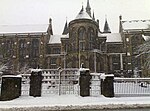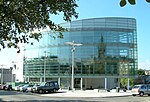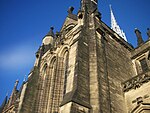Hunterian Museum and Art Gallery
1807 establishments in ScotlandArt museums and galleries in GlasgowBiographical museums in ScotlandCategory A listed buildings in GlasgowEgyptological collections in Scotland ... and 17 more
HillheadHistory museums in ScotlandInfrastructure completed in 1807Listed museum buildings in ScotlandMedical museums in ScotlandMuseums established in 1807Museums in GlasgowMuseums of ancient Greece in the United KingdomMuseums of ancient Rome in the United KingdomMusical instrument museumsNatural history museums in ScotlandScience and technology in GlasgowScience museums in ScotlandUniversity museums in ScotlandUniversity of GlasgowUse British English from May 2017William Whitfield (architect) buildings

The Hunterian is a complex of museums located in and operated by the University of Glasgow in Glasgow, Scotland. It is the oldest museum in Scotland. It covers the Hunterian Museum, the Hunterian Art Gallery, the Mackintosh House, the Zoology Museum and the Anatomy Museum, which are all located in various buildings on the main campus of the university in the west end of Glasgow.
Excerpt from the Wikipedia article Hunterian Museum and Art Gallery (License: CC BY-SA 3.0, Authors, Images).Hunterian Museum and Art Gallery
Kelvin Way, Glasgow Hillhead
Geographical coordinates (GPS) Address Website Nearby Places Show on map
Geographical coordinates (GPS)
| Latitude | Longitude |
|---|---|
| N 55.871944444444 ° | E -4.2886111111111 ° |
Address
University of Glasgow (Glasgow University)
Kelvin Way
G12 8LX Glasgow, Hillhead
Scotland, United Kingdom
Open on Google Maps






